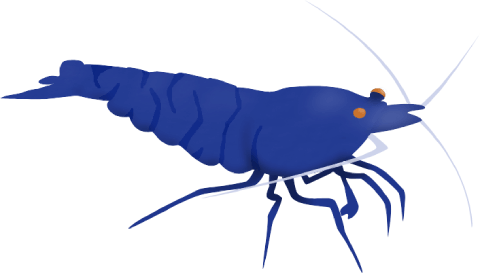- Common names
- Royal Blue Tiger Orange Eyes shrimp
Water parameters
- pH
- 7.0 - 7.5
- GH
- 4 - 10
- KH
- 1 - 8
- TDS
- 130 - 250
- Temperature
-
20 - 25 °C
68 - 77 °F
Facts
Difficulty level- Medium
Lifespan- 1 - 2 years
Origin- Taiwan
Adult size- 30 mm / 1.2 inches
Orange Eye Blue Tigers (OEBT) are a quite popular morph of the Caridina Tiger species from Taiwan. They have deep blue bodies, dark blue tiger stripes, and a very unique set of bright orange eyes.
An adult can grow to be around 3 cm (1.2 inches) in size.
Grades
Higher grade OEBTs will have strong, clearly defined tiger stripes, and almost fluorescent orange eyes.
Low grade versions will have a more translucent body with a softer blue tint. Their eyes may be closer to a brown than a punchy orange like the higher grades.
Care
Whilst a member of the Caridina species, the Orange Eye Blue Tiger is pretty hardy, generally living for 1-2 years.
Their preferred water parameters very similar to the Neocaridina species. A key difference from other Caridina is they prefer being in water with a pH between 7.0 and 7.5, which is a bit higher than most others of this species.
Unless you live somewhere very cold, Orange Eye Blue Tiger shrimp don’t require a heater. They should be absolutely fine as long as the room they’re in hovers around the 20-25 °C (68-77 °F) area most of the time.
A general rule for freshwater dwarf shrimp is to have a minimum tank size of 5 gallons (19 liters), but 10 gallons (38 liters) and larger is recommended.
Diet
Most freshwater dwarf shrimp will eat the same types of foods. They’ll spend the vast majority of their time moving around the aquarium in search of tiny bits of food like biofilm and algae, which can grow on almost any surface. If your tank is mature and heavily planted, they’ll probably have plenty of natural food to eat already.
If you’re not sure they’re getting enough to eat, there are lots of different foods for your shrimp like algae wafers, bee pollen, shrimp pellets, blanched vegetables, etc.
Giving your shrimp a variety of different foods will make it more likely they’re getting all the nutrients they need to thrive.
Tank mates
Besides the preference for a slightly higher pH, OEBTs have a fairly wide range of comfortable water parameters. This allows for quite a lot of choice of tank mates like other shrimp and snails.
You can safely introduce different colour Neocaridina shrimp, like Red Cherry, or Blue Dream etc. Likewise you could also share their tank with other Caridina types and maybe generate interesting hybrids of baby shrimp.
Find the ideal water parameters and compatible tank mates for Orange Eye Blue Tiger shrimp.
It’s sometimes possible to keep smaller fish like Neon Tetras in a shrimp tank. There is a risk that the fish will see your shrimp as food however, so you should make sure they’ve got plenty of hiding places if you wanted to try this. The risk of being eaten is much higher for baby shrimp, so if you’re planning to breed your shrimp it’s highly recommended not to have any fish in the same tank.
Breeding
Variants of the Caridina Tiger shrimp are a popular choice for breeding with other non-tiger types.
OEBTs specifically are a popular choice among breeders trying to breed new morphs with bright eyes. Most morphs with orange eyes wil likely have OEBTs in their family tree.
There are no guarantees when it comes to breeding hybrids like this but introducing Tiger genes can definitely add some unique variety to the next generation.
If you’re trying to build up a healthy population, you can read our page on how to breed shrimp for extra help.
Eyesight
It’s believed that the orange eye colour is caused by a lack of rhodopsin, a pigment found in the rods of the eye. A reduced amount of these photoreceptor proteins could cause poor vision or even blindness.
There are numerous comments online that mention OEBT shrimp seeming braver than others in the tank, like not running away when they’ve put a hand into the water. However, it’s more likely that orange eye shrimp actually just have very poor vision.


